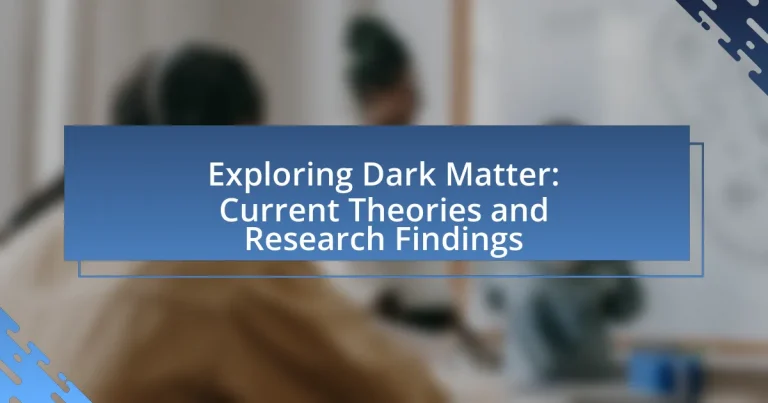Dark matter is a form of matter that is invisible and detectable only through its gravitational effects, constituting approximately 27% of the universe’s total mass-energy content. The article explores the discovery of dark matter, primarily through the work of astronomer Vera Rubin in the 1970s, and discusses the evidence supporting its existence, including galaxy rotation curves and gravitational lensing. It examines the role of dark matter in galaxy formation and cosmic structure, current theories regarding its nature, and leading candidates for dark matter particles such as Weakly Interacting Massive Particles (WIMPs) and axions. Additionally, the article highlights recent research findings, ongoing experiments, and the implications of these discoveries for our understanding of the universe.

What is Dark Matter?
Dark matter is a form of matter that does not emit, absorb, or reflect light, making it invisible and detectable only through its gravitational effects. It constitutes approximately 27% of the universe’s total mass-energy content, as evidenced by observations of galaxy rotation curves and gravitational lensing, which indicate that visible matter alone cannot account for the gravitational forces observed in galaxies and galaxy clusters.
How was Dark Matter first discovered?
Dark matter was first discovered through the observation of galaxy rotation curves by astronomer Vera Rubin in the 1970s. Rubin’s studies of spiral galaxies revealed that the outer regions of these galaxies were rotating at much higher speeds than would be expected based on the visible mass alone. This discrepancy indicated the presence of an unseen mass, which was later termed dark matter, as it could not be detected through electromagnetic radiation. The evidence from Rubin’s work, along with subsequent observations of galaxy clusters and gravitational lensing, solidified the understanding that dark matter constitutes a significant portion of the universe’s total mass.
What evidence supports the existence of Dark Matter?
The existence of dark matter is supported by several key pieces of evidence, including gravitational effects observed in galaxies and galaxy clusters. For instance, the rotation curves of spiral galaxies show that stars at the outer edges rotate at speeds that cannot be accounted for by the visible mass alone, indicating the presence of unseen mass. Additionally, the gravitational lensing effect, where light from distant objects is bent around massive clusters of galaxies, provides further evidence of dark matter’s influence, as the amount of bending corresponds to more mass than what is visible. Furthermore, the Cosmic Microwave Background radiation measurements, particularly from the Planck satellite, suggest that dark matter constitutes about 27% of the universe’s total mass-energy content, supporting its existence through cosmological observations.
How do gravitational effects indicate the presence of Dark Matter?
Gravitational effects indicate the presence of dark matter through the observation of gravitational lensing and the rotation curves of galaxies. Gravitational lensing occurs when light from distant objects is bent around massive objects, suggesting that there is more mass present than can be accounted for by visible matter. For instance, studies of galaxy clusters, such as the Bullet Cluster, show discrepancies between the visible mass and the mass inferred from gravitational lensing, indicating the presence of dark matter. Additionally, the rotation curves of galaxies reveal that stars at the outer edges rotate faster than expected based on the visible mass alone, implying that unseen mass, attributed to dark matter, is influencing their motion. This evidence collectively supports the existence of dark matter as a significant component of the universe’s mass.
Why is Dark Matter important in the universe?
Dark matter is important in the universe because it constitutes approximately 27% of its total mass-energy content, influencing the formation and structure of galaxies. Its presence is inferred from gravitational effects on visible matter, such as the rotation curves of galaxies, which show that stars at the edges rotate faster than expected based on visible mass alone. This discrepancy indicates that unseen mass, attributed to dark matter, is exerting additional gravitational pull. Furthermore, observations of cosmic microwave background radiation and large-scale structure formation support the existence of dark matter, confirming its critical role in shaping the universe’s evolution.
What role does Dark Matter play in galaxy formation?
Dark matter plays a crucial role in galaxy formation by providing the gravitational framework necessary for galaxies to form and evolve. Its presence influences the distribution of visible matter, guiding the clumping of gas and dust into galaxies. Observations indicate that dark matter constitutes about 27% of the universe’s total mass-energy content, significantly outweighing ordinary matter, which accounts for only about 5%. This imbalance allows dark matter to dominate gravitational interactions, leading to the formation of large-scale structures in the universe, such as galaxy clusters. Studies, including simulations from the Millennium Simulation project, demonstrate that dark matter halos are essential for the formation of galaxies, as they create potential wells that attract baryonic matter, facilitating star formation and galaxy growth.
How does Dark Matter influence cosmic structure?
Dark matter influences cosmic structure by providing the gravitational framework necessary for the formation and clustering of galaxies. Its presence, which constitutes approximately 27% of the universe’s total mass-energy content, affects the motion of visible matter, leading to the observed large-scale structures such as galaxy clusters and filaments. Observations, such as the rotation curves of galaxies, indicate that the visible mass alone cannot account for the gravitational forces at play, suggesting the existence of dark matter. Additionally, simulations of cosmic evolution, like those conducted by the Millennium Simulation project, demonstrate that dark matter’s gravitational pull is essential for the growth of structures over billions of years, shaping the universe’s architecture.

What are the Current Theories about Dark Matter?
Current theories about dark matter include the existence of Weakly Interacting Massive Particles (WIMPs), axions, and modifications to gravity such as Modified Newtonian Dynamics (MOND). WIMPs are hypothesized particles that could account for dark matter’s gravitational effects without interacting significantly with normal matter, supported by ongoing experiments like those at the Large Hadron Collider. Axions are theoretical particles proposed to solve the strong CP problem in quantum chromodynamics, which could also serve as dark matter candidates. MOND, on the other hand, suggests that the laws of gravity may need to be modified at large scales to explain the observed rotation curves of galaxies without invoking dark matter. Each of these theories aims to address the discrepancies between observed galactic behaviors and predictions based on visible matter alone.
What are the leading candidates for Dark Matter particles?
The leading candidates for dark matter particles include Weakly Interacting Massive Particles (WIMPs), axions, and sterile neutrinos. WIMPs are predicted by supersymmetry theories and are expected to have masses in the range of 10 GeV to several TeV, making them a primary focus in experiments like the Large Hadron Collider. Axions, theorized to solve the strong CP problem in quantum chromodynamics, are lightweight particles that could account for dark matter if they exist in sufficient quantities. Sterile neutrinos, which are hypothesized to interact only via gravity and possibly mix with regular neutrinos, could also contribute to dark matter, with mass estimates ranging from a few keV to several GeV. These candidates are supported by various theoretical frameworks and ongoing experimental searches, reinforcing their significance in the quest to understand dark matter.
What is Weakly Interacting Massive Particles (WIMPs)?
Weakly Interacting Massive Particles (WIMPs) are a class of hypothetical particles that are candidates for dark matter. They are characterized by their large mass and weak interactions with ordinary matter, making them difficult to detect. WIMPs are predicted by various theories beyond the Standard Model of particle physics, such as supersymmetry. The existence of WIMPs is supported by indirect evidence, including observations of cosmic microwave background radiation and the structure formation of the universe, which suggest that dark matter constitutes about 27% of the universe’s total mass-energy content.
How do axions fit into the Dark Matter framework?
Axions are theoretical particles that fit into the Dark Matter framework as potential candidates for explaining the nature of dark matter. They are predicted by certain extensions of the Standard Model of particle physics, particularly in the context of quantum chromodynamics (QCD), where they arise as a solution to the strong CP problem. Axions are expected to be extremely light and weakly interacting, making them difficult to detect, yet they could constitute a significant portion of the universe’s dark matter.
The existence of axions would help to account for the observed gravitational effects attributed to dark matter, such as the rotation curves of galaxies and the cosmic microwave background radiation patterns. Experimental searches, such as the Axion Dark Matter Experiment (ADMX), aim to detect axions through their predicted interactions with electromagnetic fields, providing a pathway to validate their role in the dark matter framework.
How do alternative theories challenge the existence of Dark Matter?
Alternative theories challenge the existence of Dark Matter by proposing modifications to our understanding of gravity and the dynamics of galaxies. For instance, Modified Newtonian Dynamics (MOND) suggests that the laws of gravity change at low accelerations, which could explain the observed rotation curves of galaxies without invoking Dark Matter. Additionally, theories like Emergent Gravity propose that gravity is an emergent phenomenon rather than a fundamental force, potentially eliminating the need for Dark Matter to account for gravitational effects. These alternative frameworks provide explanations for cosmic phenomena traditionally attributed to Dark Matter, thereby questioning its necessity in the current cosmological model.
What is Modified Newtonian Dynamics (MOND)?
Modified Newtonian Dynamics (MOND) is a theoretical framework that modifies Newton’s laws of motion and gravity to explain the observed rotation curves of galaxies without invoking dark matter. Proposed by Mordehai Milgrom in 1983, MOND suggests that at very low accelerations, the gravitational force behaves differently than predicted by Newtonian dynamics. This modification accounts for the discrepancy between the visible mass in galaxies and the gravitational effects observed, which typically require additional unseen mass, such as dark matter, to explain. The theory has been supported by various observational data, including the rotation curves of spiral galaxies, which show flat profiles at large distances from the galactic center, contrary to the predictions of Newtonian dynamics without dark matter.
How do these theories explain observations without Dark Matter?
Certain theories, such as Modified Newtonian Dynamics (MOND) and emergent gravity, explain astronomical observations without invoking dark matter by modifying the laws of gravity or inertia. MOND posits that at very low accelerations, the gravitational force behaves differently than predicted by Newtonian physics, which accounts for the observed rotation curves of galaxies without requiring additional mass. Emergent gravity suggests that gravity is not a fundamental force but emerges from the entropic behavior of microscopic degrees of freedom, thereby explaining phenomena like galaxy rotation and gravitational lensing through changes in spacetime geometry rather than unseen mass. These theories provide alternative frameworks that align with observational data, such as the flat rotation curves of galaxies and the distribution of galaxy clusters, without the need for dark matter.

What are the Latest Research Findings on Dark Matter?
Recent research findings on dark matter indicate that it may consist of new particles beyond the Standard Model, specifically Weakly Interacting Massive Particles (WIMPs) and axions. A significant study published in 2023 by the Fermi National Accelerator Laboratory demonstrated that the search for WIMPs continues to yield negative results, suggesting that if they exist, they are lighter than previously thought. Additionally, the European Space Agency’s Euclid mission, set to launch in 2023, aims to map the distribution of dark matter in the universe, providing insights into its properties and behavior. These findings are supported by ongoing observations from the Large Hadron Collider and various astrophysical surveys, which collectively enhance our understanding of dark matter’s role in cosmic structure formation.
What recent experiments are being conducted to detect Dark Matter?
Recent experiments to detect dark matter include the LUX-ZEPLIN (LZ) experiment, which aims to identify weakly interacting massive particles (WIMPs) using a large liquid xenon detector located in South Dakota. Additionally, the XENONnT experiment, situated in Italy, is designed to improve sensitivity to dark matter interactions by utilizing a larger target mass and advanced detection technology. Both experiments are part of a broader effort to uncover the nature of dark matter, which is believed to constitute about 27% of the universe’s mass-energy content, yet remains undetected directly.
How do underground laboratories contribute to Dark Matter research?
Underground laboratories contribute to Dark Matter research by providing a controlled environment that minimizes cosmic radiation and background noise, which can interfere with sensitive detection equipment. These laboratories, such as the Gran Sasso National Laboratory in Italy and the Sanford Underground Research Facility in the United States, are located deep underground to shield experiments from external radiation. This shielding is crucial for detecting rare interactions between Dark Matter particles and ordinary matter, as these interactions are expected to be extremely infrequent. For instance, experiments like LUX-ZEPLIN and XENONnT utilize ultra-pure liquid xenon in these underground settings to enhance their sensitivity to potential Dark Matter signals, thereby increasing the likelihood of discovering evidence for Dark Matter.
What role do astronomical observations play in Dark Matter studies?
Astronomical observations are crucial in Dark Matter studies as they provide indirect evidence of its existence through gravitational effects on visible matter. For instance, the rotation curves of galaxies, which show that stars at the edges rotate faster than expected based on visible mass alone, suggest the presence of unseen mass, attributed to Dark Matter. Additionally, observations of galaxy clusters reveal that the mass inferred from gravitational lensing exceeds the mass calculated from visible matter, further supporting the Dark Matter hypothesis. These observations collectively reinforce the understanding that Dark Matter constitutes approximately 27% of the universe’s total mass-energy content, as established by the Planck satellite measurements.
What implications do recent findings have for our understanding of the universe?
Recent findings regarding dark matter suggest that it constitutes approximately 27% of the universe’s total mass-energy content, fundamentally altering our understanding of cosmic structure and evolution. These findings indicate that dark matter influences galaxy formation and clustering, as evidenced by observations from the Hubble Space Telescope and the Cosmic Microwave Background radiation data from the Planck satellite. Such insights challenge previous models that relied solely on visible matter, emphasizing the necessity of incorporating dark matter into cosmological theories to accurately describe the universe’s behavior and development.
How might new discoveries reshape existing theories of cosmology?
New discoveries in dark matter research could significantly reshape existing theories of cosmology by providing insights into the fundamental nature of the universe. For instance, the detection of new particles or interactions related to dark matter could challenge the current Lambda Cold Dark Matter (ΛCDM) model, which relies on the existence of cold dark matter and dark energy to explain cosmic structure formation. Recent findings, such as the potential observation of dark matter interactions through experiments like the Large Hadron Collider, suggest that dark matter may not be as passive as previously thought, leading to revisions in how cosmologists understand galaxy formation and evolution. These discoveries could necessitate the development of new theoretical frameworks that incorporate these interactions, thereby altering our understanding of the universe’s expansion and the distribution of matter.
What are the potential future directions for Dark Matter research?
Potential future directions for Dark Matter research include the development of more sensitive detection methods, such as advanced particle detectors and observatories, to identify weakly interacting massive particles (WIMPs) and other candidates. Researchers are also focusing on the integration of astrophysical observations with particle physics to better understand the distribution and effects of dark matter in the universe. Additionally, theoretical advancements, including modifications to existing models and the exploration of alternative theories like Modified Newtonian Dynamics (MOND), are being pursued to explain dark matter’s properties. These directions are supported by ongoing experiments like the Large Hadron Collider and various underground laboratories, which aim to provide empirical evidence for dark matter’s existence and characteristics.
What practical steps can be taken to further Dark Matter research?
To further Dark Matter research, scientists can enhance observational techniques and invest in advanced particle detectors. Improved observational methods, such as utilizing next-generation telescopes like the James Webb Space Telescope, can provide deeper insights into cosmic structures influenced by dark matter. Additionally, funding and developing more sensitive detectors, such as those used in the Large Hadron Collider experiments, can help identify potential dark matter particles. Historical advancements, such as the discovery of the Higgs boson, demonstrate the importance of investing in cutting-edge technology to uncover fundamental particles, reinforcing the need for continued financial and collaborative support in dark matter research initiatives.
How can collaboration between disciplines enhance Dark Matter studies?
Collaboration between disciplines can enhance Dark Matter studies by integrating diverse methodologies and expertise, leading to more comprehensive research outcomes. For instance, physicists can work alongside astronomers to analyze cosmic data, while computer scientists can develop advanced algorithms for data processing. This interdisciplinary approach has been exemplified in projects like the Large Hadron Collider, where particle physics and cosmology converge to explore fundamental questions about Dark Matter. Such collaborations enable the cross-pollination of ideas, fostering innovative solutions and accelerating discoveries in understanding the nature and properties of Dark Matter.
What funding opportunities exist for Dark Matter research initiatives?
Funding opportunities for Dark Matter research initiatives include grants from national science foundations, such as the National Science Foundation (NSF) in the United States, which allocates funds specifically for astrophysics and particle physics research. Additionally, the European Research Council (ERC) provides substantial grants for innovative research projects in Europe, including those focused on Dark Matter. Furthermore, private organizations like the Simons Foundation and the Heising-Simons Foundation also offer funding for research in theoretical and experimental physics related to Dark Matter. These funding sources support a range of projects, from theoretical studies to experimental setups, ensuring a diverse approach to understanding Dark Matter.


